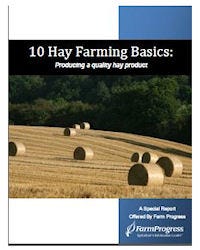
10 Hay Farming Basics: Producing A Quality Hay Product - Update
Whether a producer grows hay to feed his livestock or someone else's, the enterprise is not worthwhile unless it makes money. With the lack of feed combined with rising costs of the feed available, good hay is becoming hard to come by. Consider these 10 Hay Farming Basics to maximize the quality of your hay product.

Dear Friend,
Being a hay producer, you know demanding a good quality hay bale is. The dairy market wants large round bales; the horse market wants small square bales with fresh green looks and smell, while the cattle and beef market wants large round bales with varying quality needs.
 Knowing the basics of hay farming can take you a long way. No bale of hay is quite the same.
Knowing the basics of hay farming can take you a long way. No bale of hay is quite the same.
Take into consideration a couple of key aspects. What quality do you want? Do you know how to manage fall alfalfa for winter injury? Do you know your relative feed value and when it is best to cut? Not sure? Then download our free report: 10 Hay Farming Basics: Producing A Quality Hay Product below.
Setting The Schedule For A High Quality Hay Product
When to make that first cutting of hay sets the stage for the rest of the year.
Hay producers must answer a few questions when deciding the timing of the first spring cutting. What is the hay-harvesting schedule you desire? What are your objectives for the harvested hay crop?
Harvest schedule decisions tend to be guided by what is more important.
But do not fear. There is help in determining what kind of hay cutting schedule could be best for you. Download our free report: 10 Hay Farming Basics: Producing A Quality Hay Product.
_____
What you will learn from 10 Hay Farming Basics: Producing A Quality Hay Product
1. Set Price Based On Production Costs And Local Market
Regardless of the market, producers need to know the cost of producing the hay and the current prices in their market area that moves the hay and brings in a profit.
2. Carefully Select Alfalfa Or Grass When Choosing Varieties
Selecting the best variety, regardless of the seed cost, will pay for itself every year of the stand.
3. What To Do For Spring Forage Seeding
Forage seedings can be made in the spring as soon as a suitable seedbed can be prepared.
4. Be Careful On Slopes – Consider Erosion Protection
Consider 1 to 2 bushels of oats per acre or a reduced seeding rate of another spring cereal grain to be seeded with forage mixtures.
5. Winter Survival Comes Next: Manage Fall Hay For Winter Injury
The greatest loss to most hay growers isn't stand kill, but stand injury.
6. Fall Management Guidelines When Considering Fall Cutting
Generally, the higher the fall dormancy, the quicker the varieties start growing in spring and after each cutting.
7. Set The Schedule For Hay Quality
Deciding when to make the first cutting of hay sets the stage for the rest of the year.
8. Knowing Your RFV And Deciding When To Cut
The decision to cut should be based on feed quality needs.
9. Why You Should Know How Cool-Season Grass Grows
With grass, growth takes priority over storage for carbohydrates. Some grasses are more slow to recover than others.
10. Hay Is Worth Testing To Improve Feedings
An inexpensive hay test can offer the best guidance as to how much supplemental feed is required. Be sure to test bad hay as well.
The Bottom Line When Producing A Quality Hay Product
This free report offers you an in-depth look at a wide range of advantages in hay production strategies that can offer you guidance when preparing your hay crop for the season.
Regards,

Willie Vogt
Editorial Director
Farm Progress
About the Author(s)
You May Also Like



